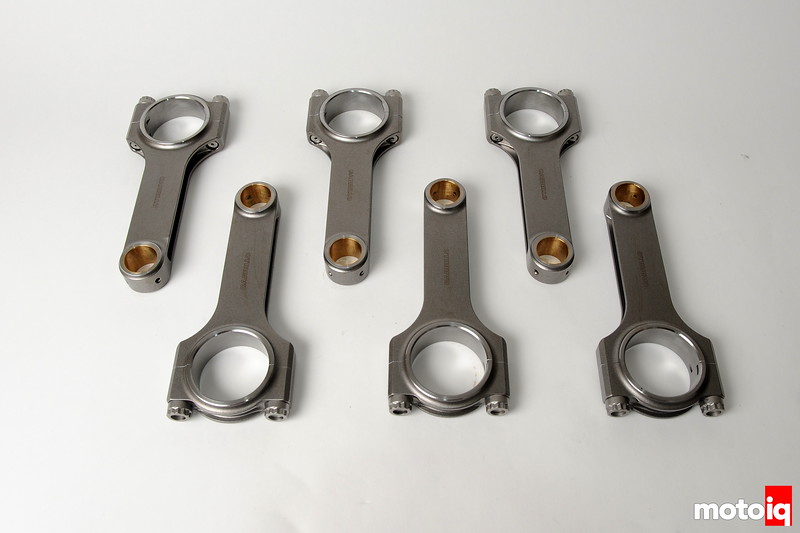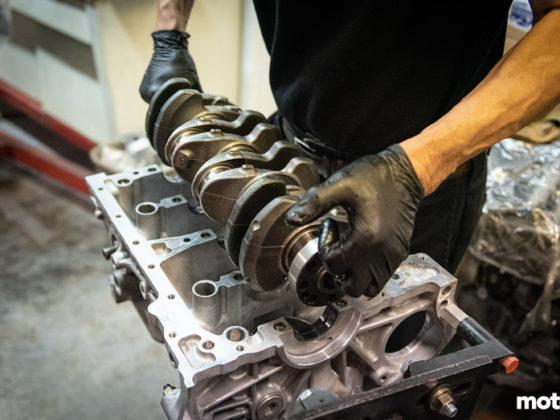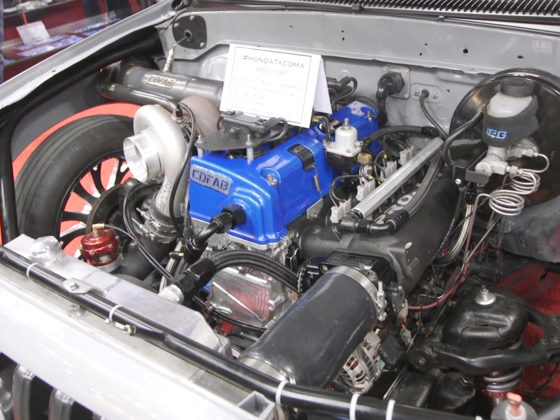
Our pistons feature the stock 9:1 compression ratio with the dome and ring grooves finished with CP’s ASF treatment which gives a super smooth surface finish that reduces carbon sticking as well as deburrs the part and reduces sharp edges which can be a start sight for detonation. In addition, we sent out CP pistons out to Swain Tech for their PC9 skirt coating. Swain Tech’s PC9 is a solid film lubricant that is extremely tough and durable. The dry film lubricant skirt coating not only helps reduce friction, but it will also help with start-up skiffing, piston bore rocking and noise by tightening up the piston to wall clearances.
The reason why we went to PC9 on the skirts is that the VR38 engine does not have conventional cylinder liners in the bores. The VR cylinders have a plasma-sprayed on liner that is only about 0.6mm thick. Because of this, the cylinders cannot be bored and you can only do a very light hone to prepare the cylinder walls for new rings. When we measured our bores the piston to wall clearance was in spec but a little on the wide end of factory tolerance. So we added the PC9 coating to tighten up the bore fitment to the pistons.
Unlike other coatings that use molybdenum disulfate as the dry lubricant, PC9 uses harder and tougher but still slippery tungsten disulfate as the solids base of the coating. This makes PC9 is pretty hard and durable which works well for this sort of application. In addition, Swain can control the thickness of the coating and you can specify the thickness you want within reason. If the clearances are a little tight after coating, never fear the PC9 will burnish in without scuffing.

Our pistons use a dedicated near-net-shape forging for maximum strength and minimum weight. The pistons feature a full-width pin boss for better support of the piston pin. This works better for high boost turbo engines that the reduced boss with short pins which are favored for NA engines. As machined from CP our pistons are balanced within one gram of each other.

Our CP pistons feature a full skirt. Some engine builders prefer this on a high cylinder pressure turbo engine accepting more friction for more thrust side support and possibly better stability in the bore. Our pistons have a pressure accumulator grove between the compression rings. This reduces combustion pressure build-up in between the rings reducing flutter and improving the seal of the top ring and reducing back pressure and premature wear on the second ring.

 In The main bearings feature Kings U-Groove technology with 90-degree walls on the oil feed grooves which give more bearing surface area. The oil feed holes that deliver oil to the grooves feature Kings ElliptiX oil feed hole design. The feed holes are chamfered and lengthened to help improve the oil feed which helps assure that the rod bearings have enough oil supply. King bearings are very tightly toleranced across the bearing face so the oil clearance is consistent across the crank journal.
In The main bearings feature Kings U-Groove technology with 90-degree walls on the oil feed grooves which give more bearing surface area. The oil feed holes that deliver oil to the grooves feature Kings ElliptiX oil feed hole design. The feed holes are chamfered and lengthened to help improve the oil feed which helps assure that the rod bearings have enough oil supply. King bearings are very tightly toleranced across the bearing face so the oil clearance is consistent across the crank journal.




10 comments
i had always heard that Nissan engines, particularly the RBs, were underpowered in comparison to how robust they were. Those days, apparently, are long gone when we get 500+ HP out of bolt-on upgrades.
Any downsides to the narrow rod bearings?
Less surface area to maintain the oil film so less pressure needed before getting bearing wear. Good oil flow and pressure can somewhat mitigate it.
Very nice article, really accessible, will there be updates?
Also, I couldn’t help wonder, was there any discussion about the downpipes getting coated? Did any other goodies get thrown in “since you were in there anyway?”
Been a reader since SCC and still miss that magazine!
Other than the PC9 coating on the pistons, the parts were kept mostly stock. This was a customer car and they just wanted their car back. Though it may not seem like a lot was done, the total gets up there pretty quick thanks to the GT-R tax.
Great write up guys. Just to add some context:
The original motor was stock with about 90k mi on it, most of which was spent with the boost up for WOT on E85. It was not in fact bad gas that lead to failure but rather an accidental downshift at WOT which resulted in a low RPM load on the OEM rods. If that had not happened, my guess is the engine would still be alive. That tune had a reduction in torque as mentioned in the article. But even with the motor build, that mistake should not be repeated. if you have a GTR – don’t let that happen!
The owner just dynod the new setup and the results were impressive with the stock turbos. The head work appears to have netted a consistent gain in TQ across the rev range; but more impressively the peak TQ RMP was lowered by over 700 RPM’s down to 3,500 RPM’s.
Great build guys. Hi Howard, Mike and Martin.
I’ve really loved all of these modification articles / videos on the project GT-R. I was wondering if you would be making a video comparing the modified car’s performance to a stock car? Maybe quarter mile, 0-62, and a few laps on a track or Auto-X?
I think it would be really great to have some sort of benchmarking so that owners will know how the mods improve the car in more sure terms.
Thanks,
The car came here with a windowed block so no before!
could you be so kind to share you piston to wall clearance along with main and rod bearing clearance. this seems to be a very secretive issue when it comes to building a vr38 motor for about 1200hp or so.
We don’t give that information away either. Its part of our engine building service.